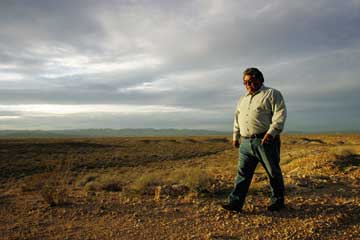ver since a 1987 U.S. Supreme Court decision restricted state regulation of gambling on reservations, Native Americans and economic development have usually convened at the gaming table. But new projects and policies have given North American
|
|

|
|
LAND OF MANY VALUES: Phil Swain, chairman of the Moapa Business Council, looks over tribal land in Nevada that will soon host the construction of a $300-million portland cement plant from Ash Grove Cement Co. Photo credit: Eric Jamison, Opulence Studios |
tribes more prominent roles in some major industrial projects too. With them come the promise of better jobs and more diversified and integrated community economies among the 562 tribes in the U.S., and those in Canada as well.
The time is certainly ripe for that diversification: In September, a survey of Indian housing authorities conducted by the National American Indian Housing Council found that the unemployment rate among tribes with gaming was 42 percent — just one percentage point lower than the average rate across all constituencies, and eight times the national average. And 62 percent of respondents said lack of capital was the biggest obstacle to economic development, trailed slightly by remote locations of reservations.
Furthermore, a Sept. 27 report in The Wall Street Journal documented how Native American gambling revenues have risen from under US$4 billion in 1994 to around $19 billion in 2004, but the growth rate — along with the economic vitality of some tribal communities — has stagnated. What’s more, questions from the IRS about the legality of using tax-exempt bonds to pay for casino projects has stifled the boom even more: Original language in 1982 legislation concerning the issuance of these bonds referred to their use for an “essential government function.” According to the Journal, many of these bonds were used for industrial properties as well as casino projects, and a 1987 amendment labeled certain industrial and commercial projects as outside the bounds of tax-exempt bonds.
Certain projects however, bonds or no bonds, continue to unfold from coast to coast. Some are driven by small business: According to the U.S. Dept. of Commerce, the number of Native American-owned businesses increased by 84 percent between 1997 and 2000. But the bigger industrial projects are frequently in line with top-line national demand for energy and building materials.